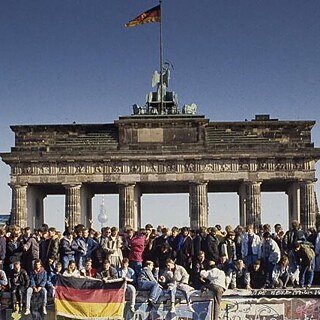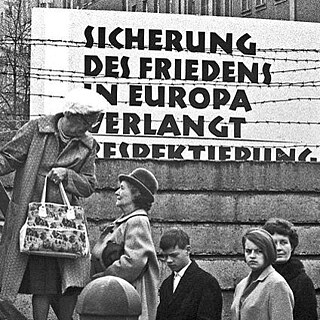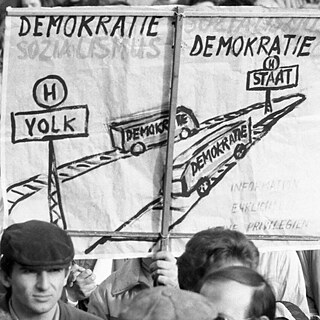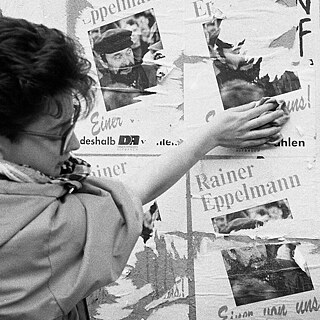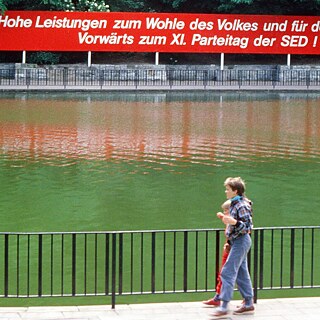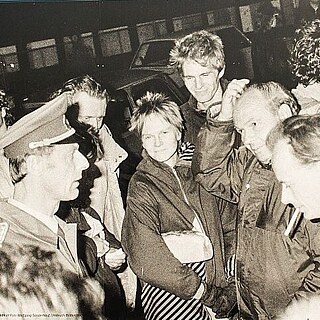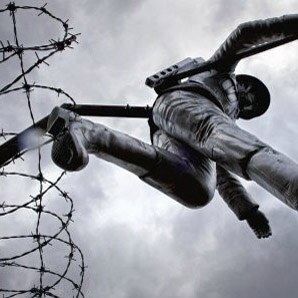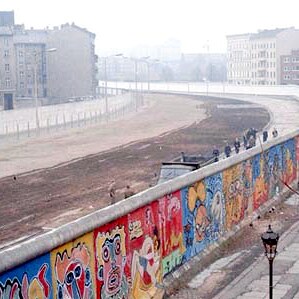
Show description in:
Chapter 19Commonalities and differences FRG vs GDR: Social Control

How much control is necessary for a society to function and how can the example of the Stasi help us understand today’s situation with policing, surveillance and big data?
Characteristics
Language level
Target group
Skill

Part of the series Divided Germany, the wall and reunification
26 materials
Description
How much control is necessary for a society to function and how can the example of the Stasi help us understand today’s situation with policing, surveillance and big data? The Ministry for State Security of the GDR, the Stasi (1950-1990) is known as one of the most effective and repressive secret police agencies of our time. Stasi collaborators permeated GDR society and in addition to exerting psychological trauma on people under investigation, this vast network of informants collected over 111 kilometers (69 miles) of documents (written notes, photos, slides, flim and sound recording). Social control existed on the other side of the border too, with intelligence agencies in the FRG collecting data on citizens.
Videos
1. STASI ARCHIVES AND STASI FILES
Where were the STASI files collected? What does the archive look like? Anthropologist Ulrike Neuendorf, PhD, takes us on a quick tour.
2. THE STASI EXPLAINED
What was the Stasi and how did it work? Ulrike Neuendorf PhD, introduces the Stasi.
3. INFORMING FOR THE STASI
Why did East German citizens work for the Stasi? Did they have a choice?
4. WAS ESCAPE POSSIBLE?
Could anyone escape social control by the Stasi? Ulrike Neuendorf, PhD, talks about the pervasive network built by the Stasi.
5. A PERSONAL STORY: FROM PRISON TO FREEDOM
In 1987, Mario Röllig attempted to flee the GDR to Yugoslavia, but he was caught at the Hungarian border and brought back to Germany, where he landed at the infamous Stasi-prison Berlin- Hohenschönhausen. In German with English subtitles.
6. PROTECTION FROM WHAT?
Capitalism? The outside world? LIsten to Jonathan Zatlin, PhD, professor of history at Boston University, discuss what the Stasi was protecting East German citizen from.
7. ESCAPE FROM THE GDR
What were the challenges that Diana Erinna faced when escaping the GDR via Czechoslovakia, Hungary and Austria?
8. FAKE NEWS?
Were East Germans ever worried that their Western News were actually fake news? If so, were there any major instances where the government interfered with the Western broadcasts?
9. LIVING LIFE LOOKING OVER YOUR SHOULDER
How does one live daily life when you know that surveillance is everywhere? Diana Erinna discusses the effects of everyday surveillance.
10. POLICE BRUTALITY: A COMPARISON
Was police brutality the same? Listen to Jonathan Zatlin, PhD, discuss two incidents with police in West and East Germany.
11. SOCIAL CONTROL
How did young people in the GDR organize or rebell against power? Alissa Bellotti, PhD, discusses youth rebellion.
12. EXPERIENCING SURVEILLANCE
How was surveillance experienced by East German citizens? Ulrike Neuendorf, PhD, discusses the long-term implication of surveillance.
13. STASI COLLABORATION: AFTER REUNIFICATION
After Reunification: Ulrike Neuendorf, PhD, discusses what it meant to have worked for the Stasi.
14. STASI AND PRESENT- DAY SURVEILLANCE
To what extent does the example of the police state created and sustained by the Stasi in East Germany help us understand today situation with surveillance?
15. STASI AND TODAY'S SITUATION WITH SURVEILLANCE
Is the example of the police state Stasi comparable with today's collection of personal data?
16. ALL POWERFUL STATE CONTROL: POSSIBLE? NECESSARY?
Is an all powerful state control possible and necessary? Andrew Port, PhD, discusses the limits of control.
17. POLICING TODAY
Recently in the US there have been calls to defund the police. At what point does policing make society less safe?
18. NO SOCIAL CONTROL?
Donald Zoffel of Mt. Lebanon HS in Pittsburgh, PA, asks General Consul in NY David Gill: Could there exist a government that protects its citizens without the need for control? If so, how would that look like?
Other resources
Orte der Repression / Place of repression
PARTNERS
Bundesstiftung Aufarbeitung der SED-Diktatur (Federal Foundation for the Reappraisal of the SED Dictatorship), German Consulate General New York, German American Partnership Program (GAPP), American Association of Teachers of German (AATG), Transatlantic Outreach Program (TOP) and Spark for German.
Videos
1. STASI ARCHIVES AND STASI FILES
Where were the STASI files collected? What does the archive look like? Anthropologist Ulrike Neuendorf, PhD, takes us on a quick tour.
2. THE STASI EXPLAINED
What was the Stasi and how did it work? Ulrike Neuendorf PhD, introduces the Stasi.
3. INFORMING FOR THE STASI
Why did East German citizens work for the Stasi? Did they have a choice?
4. WAS ESCAPE POSSIBLE?
Could anyone escape social control by the Stasi? Ulrike Neuendorf, PhD, talks about the pervasive network built by the Stasi.
5. A PERSONAL STORY: FROM PRISON TO FREEDOM
In 1987, Mario Röllig attempted to flee the GDR to Yugoslavia, but he was caught at the Hungarian border and brought back to Germany, where he landed at the infamous Stasi-prison Berlin- Hohenschönhausen. In German with English subtitles.
6. PROTECTION FROM WHAT?
Capitalism? The outside world? LIsten to Jonathan Zatlin, PhD, professor of history at Boston University, discuss what the Stasi was protecting East German citizen from.
7. ESCAPE FROM THE GDR
What were the challenges that Diana Erinna faced when escaping the GDR via Czechoslovakia, Hungary and Austria?
8. FAKE NEWS?
Were East Germans ever worried that their Western News were actually fake news? If so, were there any major instances where the government interfered with the Western broadcasts?
9. LIVING LIFE LOOKING OVER YOUR SHOULDER
How does one live daily life when you know that surveillance is everywhere? Diana Erinna discusses the effects of everyday surveillance.
10. POLICE BRUTALITY: A COMPARISON
Was police brutality the same? Listen to Jonathan Zatlin, PhD, discuss two incidents with police in West and East Germany.
11. SOCIAL CONTROL
How did young people in the GDR organize or rebell against power? Alissa Bellotti, PhD, discusses youth rebellion.
12. EXPERIENCING SURVEILLANCE
How was surveillance experienced by East German citizens? Ulrike Neuendorf, PhD, discusses the long-term implication of surveillance.
13. STASI COLLABORATION: AFTER REUNIFICATION
After Reunification: Ulrike Neuendorf, PhD, discusses what it meant to have worked for the Stasi.
14. STASI AND PRESENT- DAY SURVEILLANCE
To what extent does the example of the police state created and sustained by the Stasi in East Germany help us understand today situation with surveillance?
15. STASI AND TODAY'S SITUATION WITH SURVEILLANCE
Is the example of the police state Stasi comparable with today's collection of personal data?
16. ALL POWERFUL STATE CONTROL: POSSIBLE? NECESSARY?
Is an all powerful state control possible and necessary? Andrew Port, PhD, discusses the limits of control.
17. POLICING TODAY
Recently in the US there have been calls to defund the police. At what point does policing make society less safe?
18. NO SOCIAL CONTROL?
Donald Zoffel of Mt. Lebanon HS in Pittsburgh, PA, asks General Consul in NY David Gill: Could there exist a government that protects its citizens without the need for control? If so, how would that look like?
Other resources
Orte der Repression / Place of repression
PARTNERS
Bundesstiftung Aufarbeitung der SED-Diktatur (Federal Foundation for the Reappraisal of the SED Dictatorship), German Consulate General New York, German American Partnership Program (GAPP), American Association of Teachers of German (AATG), Transatlantic Outreach Program (TOP) and Spark for German.
